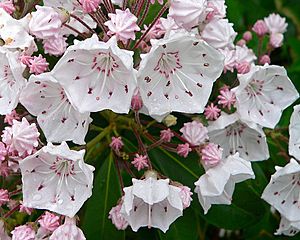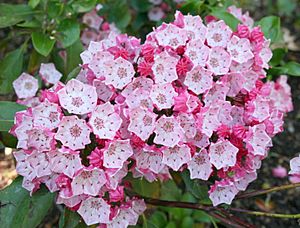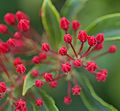Mountain laurel facts for kids
Quick facts for kids Mountain laurel |
|
|---|---|
 |
|
| Kalmia latifolia flowers | |
| Conservation status | |
| Scientific classification | |
| Genus: |
Kalmia
|
| Species: |
latifolia
|
 |
|
Kalmia latifolia, often called mountain laurel, calico-bush, or spoonwood, is a type of evergreen shrub. It belongs to the heather family. This plant grows naturally in the eastern United States. You can find it from southern Maine all the way down to northern Florida. It also grows west into Indiana and Louisiana. The mountain laurel is the state flower for Connecticut and Pennsylvania. It even gave its name to Laurel County in Kentucky, the city of Laurel, Mississippi, and the Laurel Highlands in southwestern Pennsylvania.
Contents
How Mountain Laurel Grows
Kalmia latifolia is an evergreen shrub that can grow quite tall, usually between 3 to 9 meters (about 10 to 30 feet). Its leaves are about 3 to 12 centimeters (1 to 5 inches) long and 1 to 4 centimeters (0.4 to 1.6 inches) wide.
The flowers are round and can be light pink or white. They grow in bunches. Today, there are many special types of mountain laurel called cultivars. These have flowers with darker pink, red, or maroon colors. The plant blooms in May and June. It's important to know that all parts of this plant are poisonous. Its roots are strong and grow in a thick mat.
You'll often find mountain laurel on rocky slopes and in mountain forests. It loves acidic soil, which means the soil is a bit sour, like a pH of 4.5 to 5.5. This plant often grows in large, dense patches called thickets. These thickets can cover big areas of the forest floor. In the Appalachians, mountain laurel can even grow as tall as a tree. But farther north, it usually stays a shrub. In some wet areas, it grows very thickly. In dry, higher areas, it grows more spread out. In the southern Appalachians, these thick laurel patches are sometimes called "laurel hells." This is because they are so dense that it's almost impossible to walk through them!
How Mountain Laurel Reproduces
Kalmia latifolia has a very interesting way of spreading its pollen. As the flower grows, the thin stalks (called filaments) of its stamens bend. This creates tension, like a spring being pulled back. When an insect lands on the flower, this tension is suddenly released. The pollen is then forcefully shot onto the insect!
Scientists have done experiments showing that the flower can fling its pollen up to 15 centimeters (about 6 inches). A physicist named Lyman James Briggs became very interested in this in the 1950s. He did many experiments to understand how it worked.
Names and History
Kalmia latifolia is also known as ivybush or spoonwood. It got the name "spoonwood" because Native Americans used its wood to make spoons.
The plant was first written about in America in 1624. However, it was named after a Finnish explorer and botanist named Pehr Kalm (1716–1779). He was the one who sent samples of the plant to the famous scientist Carl Linnaeus.
The Latin part of its scientific name, latifolia, means "with broad leaves." This helps tell it apart from its close relative, Kalmia angustifolia, which means "with narrow leaves."
Growing Mountain Laurel

Mountain laurel was first brought to Europe in the 1700s. People grew it there as an ornamental plant, meaning it was grown for its beauty. It is still very popular today because of its lovely flowers and its green leaves that stay all year.
Its leaves are oval-shaped, grow in pairs, feel leathery, and are shiny. They can be up to 5 inches long. They are dark green on top and yellowish-green underneath. They look a lot like the leaves of rhododendrons. Remember, all parts of this plant are toxic if eaten.
Many different types of mountain laurel, called cultivars, have been created. These have flowers with various colors. A lot of these special types came from the Connecticut Experiment Station in Hamden. Dr. Richard Jaynes did a lot of work breeding these plants. He has created many named varieties and is known as the world's top expert on Kalmia latifolia.
In the UK, some of these special types have won an award called the Royal Horticultural Society's Award of Garden Merit. These include:
- 'Freckles' – has pale pink flowers with many spots.
- 'Little Linda' – a small type that grows to about 1 meter (3 feet) tall.
- 'Olympic Fire' – has red buds that open into pale pink flowers.
- 'Pink Charm'
Mountain Laurel Wood
The wood from the mountain laurel is heavy and strong, but it can also be brittle. It has a tight, straight grain. This wood has never been used much for commercial purposes because the trees don't grow large enough. However, it is good for making wreaths, furniture, bowls, and other items for the home.
In the early 1800s, it was used in wooden clocks. During World War II, people used the knotty growths (called burls) from the roots to make pipe bowls. This was because they couldn't get the usual wood from other countries. Mountain laurel wood can also be used to make handrails or guard rails.
Is Mountain Laurel Poisonous?
Yes, mountain laurel is poisonous to many animals. This includes horses, goats, cattle, deer, monkeys, and humans.
Native American Uses
The Cherokee people used the mountain laurel plant in several ways. They would make a liquid from the leaves and put it on scratches over painful areas to help with pain. They also rubbed the rough edges of ten to twelve leaves on their skin for rheumatism.
If they got scratches from thorny plants, they would crush the leaves and rub them on the scratches. They also used a liquid from the plant as a wash to "get rid of pests." A mix of plant parts was used as a liniment (a rub for pain). Ball players would rub the sticky liquid from the leaves onto their scratched skin to prevent muscle cramps. They also used a salve (a healing ointment) made from the leaves. Besides medicine, the Cherokee also used the wood for carving.
Images for kids
See also
 In Spanish: Kalmia latifolia para niños
In Spanish: Kalmia latifolia para niños










